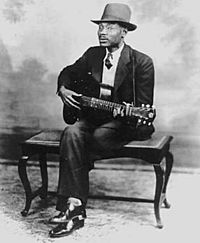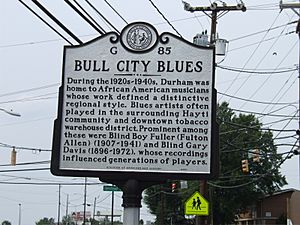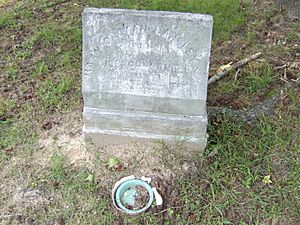Blind Boy Fuller facts for kids
Quick facts for kids
Blind Boy Fuller
|
|
|---|---|

Studio portrait of Fuller
|
|
| Background information | |
| Birth name | Fulton Allen |
| Born | July 10, 1904 Wadesboro, North Carolina, U.S. |
| Died | February 13, 1941 (aged 36) Durham, North Carolina, U.S. |
| Genres | |
| Instruments |
|
| Years active | 1928–1940 |
Fulton Allen (born July 10, 1904 – died February 13, 1941), known as Blind Boy Fuller, was an American blues guitarist and singer. He was one of the most popular musicians who played Piedmont blues. This style of blues music came from the southeastern United States. Other famous Piedmont blues artists included Blind Blake, Josh White, and Buddy Moss.
Life Story and Music Career
Fulton Allen was born in Wadesboro, North Carolina, in the United States. He was one of ten children. After his mother passed away, he moved with his father to Rockingham, North Carolina. As a boy, he learned to play the guitar. He also learned many traditional songs and blues tunes from older singers in his community.
When he was a teenager, he started to lose his eyesight. By 1928, he was completely blind. Because he could no longer work as a laborer, he became a street performer and singer. He played his guitar on street corners and at parties in cities like Winston-Salem, North Carolina, and Durham, North Carolina. He learned a lot by listening to other country blues players like Blind Blake and Gary Davis.
In Durham, he became very popular, especially around the tobacco warehouses. Other musicians like Floyd Council, Richard Trice, Sonny Terry (who played harmonica), and George Washington (who played washboard and guitar) often played with him.

In 1935, a record store manager named James Baxter Long helped Fuller get a chance to record his music. Fuller, Gary Davis, and George Washington recorded several songs in New York City. One of these was the traditional song "Rag, Mama, Rag". To help sell the records, Long gave Fulton Allen the stage name Blind Boy Fuller.
Over the next five years, Fuller recorded more than 120 songs. His singing style was very direct and honest. His songs often talked about his life experiences as a blind man living in the city. He sang about everyday things like pawnshops, sickness, and humor. Even though his songs were simple, they were very real and showed his feelings.
In 1936, Fuller recorded ten solo songs and also played with guitarist Floyd Council. The next year, he recorded for Decca Records and later with Sonny Terry.
Fuller's last recording sessions were in New York City in June 1940. By this time, he was becoming weaker, and his later songs didn't have the same energy as his earlier ones.
Fuller was known for his amazing fingerpicking style on his steel National resonator guitar. He often played fast, upbeat songs, including his famous hit "Step It Up and Go". He also sang deeper, more emotional songs like "Lost Lover Blues". Many of his songs were based on old folk and blues tunes. He was very good at taking traditional songs and making them his own, which made him popular with many listeners. His music continues to influence other Piedmont blues artists today.
His Passing
Blind Boy Fuller passed away at his home in Durham, North Carolina, on February 13, 1941.
He was so well-known that another musician, Brownie McGhee, recorded a song called "The Death of Blind Boy Fuller". Brownie McGhee then briefly performed as "Blind Boy Fuller No. 2" to continue the popular sound.
Where He is Buried
Blind Boy Fuller is buried in Grove Hill Cemetery in Durham. This cemetery is on private land, but it was once an official cemetery. Fuller's burial is recorded there. Today, only one headstone remains in the cemetery, which belongs to Mary Caston Langey.
Fuller has been honored with two special plaques in Durham. One plaque, placed by the state of North Carolina, is a few miles north of his gravesite. The city of Durham also honored him on July 16, 2001, with another plaque. This one is located near the American Tobacco Trail, close to where his unmarked grave is.
Later Recognition
Blind Boy Fuller, along with Reverend Gary Davis, was honored at the Durham 150 Closing Ceremony in November 2019. They were recognized for their important contributions to Piedmont blues music. Many rock artists, like the Rolling Stones, Rory Gallagher, and Eric Clapton, have said that Fuller's blues music influenced them. Syd Barrett of the band Pink Floyd even got the idea for his band's name from seeing the names of blues singers Pink Anderson and Floyd Council on one of Fuller's album covers.
See also
 In Spanish: Blind Boy Fuller para niños
In Spanish: Blind Boy Fuller para niños


